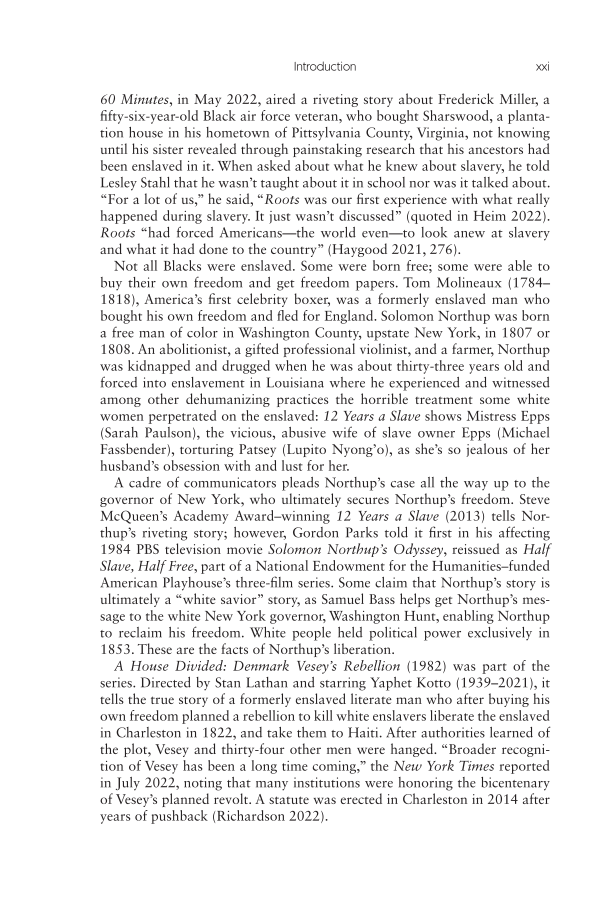Introduction xxi 60 Minutes, in May 2022, aired a riveting story about Frederick Miller, a fifty-six-year-old Black air force veteran, who bought Sharswood, a planta- tion house in his hometown of Pittsylvania County, Virginia, not knowing until his sister revealed through painstaking research that his ancestors had been enslaved in it. When asked about what he knew about slavery, he told Lesley Stahl that he wasn’t taught about it in school nor was it talked about. “For a lot of us,” he said, “Roots was our first experience with what really happened during slavery. It just wasn’t discussed” (quoted in Heim 2022). Roots “had forced Americans—the world even—to look anew at slavery and what it had done to the country” (Haygood 2021, 276). Not all Blacks were enslaved. Some were born free some were able to buy their own freedom and get freedom papers. Tom Molineaux (1784– 1818), America’s first celebrity boxer, was a formerly enslaved man who bought his own freedom and fled for England. Solomon Northup was born a free man of color in Washington County, upstate New York, in 1807 or 1808. An abolitionist, a gifted professional violinist, and a farmer, Northup was kidnapped and drugged when he was about thirty-three years old and forced into enslavement in Louisiana where he experienced and witnessed among other dehumanizing practices the horrible treatment some white women perpetrated on the enslaved: 12 Years a Slave shows Mistress Epps (Sarah Paulson), the vicious, abusive wife of slave owner Epps (Michael Fassbender), torturing Patsey (Lupito Nyong’o), as she’s so jealous of her husband’s obsession with and lust for her. A cadre of communicators pleads Northup’s case all the way up to the governor of New York, who ultimately secures Northup’s freedom. Steve McQueen’s Academy Award–winning 12 Years a Slave (2013) tells Nor- thup’s riveting story however, Gordon Parks told it first in his affecting 1984 PBS television movie Solomon Northup’s Odyssey, reissued as Half Slave, Half Free, part of a National Endowment for the Humanities–funded American Playhouse’s three-film series. Some claim that Northup’s story is ultimately a “white savior” story, as Samuel Bass helps get Northup’s mes- sage to the white New York governor, Washington Hunt, enabling Northup to reclaim his freedom. White people held political power exclusively in 1853. These are the facts of Northup’s liberation. A House Divided: Denmark Vesey’s Rebellion (1982) was part of the series. Directed by Stan Lathan and starring Yaphet Kotto (1939–2021), it tells the true story of a formerly enslaved literate man who after buying his own freedom planned a rebellion to kill white enslavers liberate the enslaved in Charleston in 1822, and take them to Haiti. After authorities learned of the plot, Vesey and thirty-four other men were hanged. “Broader recogni- tion of Vesey has been a long time coming,” the New York Times reported in July 2022, noting that many institutions were honoring the bicentenary of Vesey’s planned revolt. A statute was erected in Charleston in 2014 after years of pushback (Richardson 2022).
Document Details My Account Print multiple pages
Print
You have printed 0 times in the last 24 hours.
Your print count will reset on at .
You may print 0 more time(s) before then.
You may print a maximum of 0 pages at a time.
















































































































































































































































